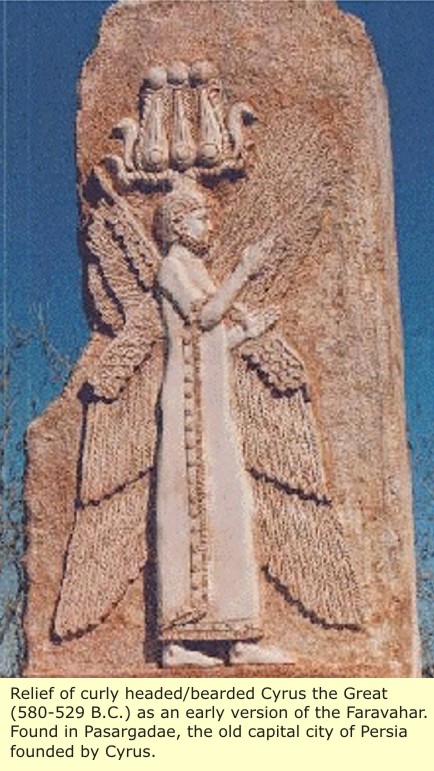
Elam & Akkadian Empire |
Babylonian Empire |
Assyrian Empire |
Achaemenid Persian Empire |
Alexanders Empire |
Seleucid Empire |
Parthian Empire |
Sassanian Persian Empire |
Ottoman Empire |
Modern Iran
When last we left Elam, the Babylonians and the Medes of Media, had destroyed the Assyrian Empire.
Media - the kingdom of the Medes, was however, soon overthrown by the rise of the Persians, they were lead by their king "Cyrus II" (Cyrus the Great), of Persia. While the Medes had been busy with the Assyrians, Cyrus had managed to unite under his authority several Persian and Elamite tribes who were not under Median control.
Eventually, he openly rebelled against the Medes, who he then bested in battle. In these battles, considerable numbers of Median troops deserted to the Persian side. Thus in 550 B.C, the Median Empire became a part of the first Persian Empire. The Achaemenian kings must have appeared on the international scene, with a suddenness that frightened many.
 |
 |
 |
 |
The religion of the Persians was Zoroastrianism, and their name for their god was "Ahura Mazda". The symbol for their religion - Not their God - was the "Faravahar". The Persians were devoutly religious and had many strict rules and prohibitions. Of particular distaste to the Persians, was the lie. The Achaemenian kings, did not discriminate against other religions, and did not seek to force others to their faith. Many aspects of Zoroastrianism were later incorporated into the Hebrew religion.
In his mind, Cyrus saw the world as being full of evil and disorder, and felt it was incumbent upon him, to bring order to the world. And in his thinking, the only way to do that, was to conquer it!
 |
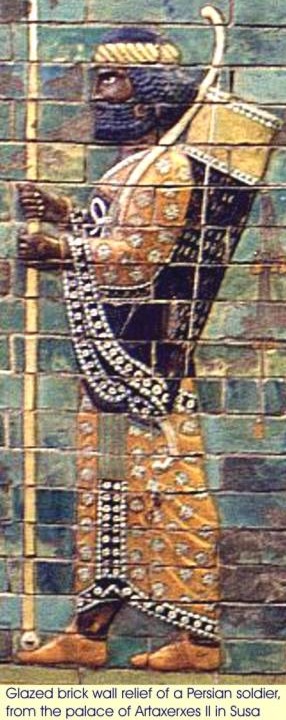
Cyrus then went about conquering every land that he could find, and then finally, he turned on Babylon. As you will recall from the Sumer section: the Marduk Priesthood in Babylon had already set the stage. The fall of Babylon came about almost as an anticlimax. The fall of the greatest city in the Middle East was swift; Cyrus marched in - this was late in the summer of 539 B.C, and seized the hands of the statue of the god Marduk, this as a signal of his willingness to rule as a Babylonian, and not as a foreign conqueror. With this, he was thus hailed as the legitimate successor to the throne. In this one stride, Cyrus carried Persian power to the borders of Egypt, for with Babylon, came all that it had previously seized from the Assyrians, and also, that which it had later gained on it's own.
By the order of Cyrus, all the captive nationalities that had been held for generations in Babylon were freed, and their return to their homelands was financed by him. Among the liberated captives were 50,000 Hebrews held in Babylon for three generations. Their instruction was to return to their homeland and rebuild their temple. This is a policy that was also followed by Cyrus's successors. Some of the liberated Hebrews were invited to, and did settle in Persia.
Because of such a generous act, Cyrus has been
anointed in the Bible. He is the only gentile in the Bible who has been
titled Messiah. And he is mentioned explicitly as the Lord's shepherd
and his anointed (Messiah). Other references to Cyrus are attested to
in Isaiah 45:4, where Cyrus is called by name and given a title of
honor; he is also called to rebuild God's city and free His people in
(Is. 45:13), and he is chosen, called, and brought through successful
by God in (Is. 48:14-15).
Upon the death of Cyrus the Great, the Empire passed to his son Cambyses II (reigned 529–522 B.C). At this time, there may have been some degree of unrest throughout the empire, for with Cyrus's death, Cambyses apparently felt it necessary to secretly kill his brother, Bardiya (Smerdis). The campaign against Egypt began in 525 B.C.
The Egyptian pharaoh, Ahmose II of the 26th dynasty, sought to shore up his defenses against the Persians by hiring Greek mercenaries, but he was betrayed by the Greeks. Cambyses successfully managed to cross the hostile Sinai Desert, traditionally Egypt's first and strongest line of defense, and engaged the Egyptians forces under the command of Psamtik III in a battle at Pelusium. The Egyptians lost and were forced to retire to Memphis, which subsequently fell to the Persians, as did all of Egypt later.
 |
 |
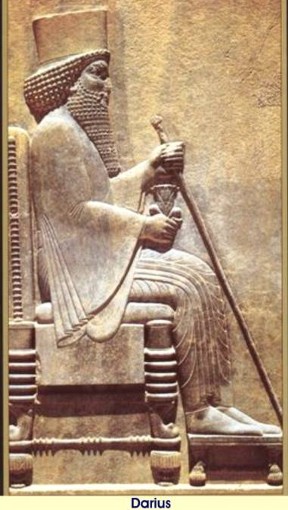
Within little more than a Century after the Assyrian Ashurbanipal's salt sowing, the great Elamite city of Susa was rebuilt by Darius I, the successor to Cambyses II, at around 518 B.C. Darius took care to record that he had adorned the city with gold from Sardis and Bactria, ivory from Egypt and Ethiopia, and cedar wood from Lebanon. This was afforded by the tribute that came to him from controlling two million square miles of territory, stretching from Egypt and the Aegean sea, well into India, and from the Persian Gulf to the Caspian and Black Seas.
Susa once more became the glowing city - as described in the Bible - with monumental buildings furnished with "Marble pillars, couches of gold and silver, on a mosaic pavement of porphyry, marble, mother of pearl and precious stones". Thus restored, Susa lasted for another 1,700 years, and than sadly, was destroyed by the Mongol invaders in about 1200 A.D. It was never again rebuilt.
The Greco-Persian Wars were a series of conflicts between the Achaemenid Empire of Persia and city-states of the Hellenic world that started in 499 B.C, and lasted until 449 B.C. The collision between the fractious political world of the Greeks and the enormous empire of the Persians began when Cyrus the Great conquered Ionia in 547 B.C, Struggling to rule the independent-minded cities of Ionia, the Persians appointed tyrants to rule each of them. This would prove to be the source of much trouble for the Greeks and Persians alike.
In 499 B.C, the then tyrant of Miletus, Aristagoras, embarked on an expedition to conquer the island of Naxos, with Persian support; however, the expedition was a debacle and, pre-empting his dismissal, Aristagoras incited all of Hellenic Asia Minor into rebellion against the Persians. This was the beginning of the Ionian Revolt, which would last until 493 B.C, progressively drawing more regions of Asia Minor into the conflict. Aristagoras secured military support from Athens and Eretria, and in 498 B.C, these forces helped to capture and burn the Persian regional capital of Sardis. The Persian king Darius the Great vowed to have revenge on Athens and Eretria for this act. The revolt continued, with the two sides effectively stalemated throughout 497–495 BC. In 494 B.C, the Persians regrouped, and attacked the epicentre of the revolt in Miletus. At the Battle of Lade, the Ionians suffered a decisive defeat, and the rebellion collapsed, with the final members being stamped out the following year.
Seeking to secure his empire from further revolts and from the interference of the mainland Greeks, Darius embarked on a scheme to conquer Greece and to punish Athens and Eretria for burning Sardis. The first Persian invasion of Greece began in 492 B.C, with the Persian general Mardonius conquering Thrace and Macedon before several mishaps forced an early end to the campaign. In 490 B.C, a second force was sent to Greece, this time across the Aegean Sea, under the command of Datis and Artaphernes. This expedition subjugated the Cyclades, before besieging, capturing and razing Eretria. However, while on route to attack Athens, the Persian force was decisively defeated by the Athenians at the Battle of Marathon, ending Persian efforts for the time being. Darius then began to plan to complete the conquest of Greece, but died in 486 BC and responsibility for the conquest passed to his son Xerxes I. In 480 B.C, Xerxes personally led the second Persian invasion of Greece with one of the largest ancient armies ever assembled. Victory over the 'Allied' Greek states (led by Sparta and Athens) at the Battle of Thermopylae allowed the Persians to overrun most of Greece. However, while seeking to destroy the combined Greek fleet, the Persians suffered a severe defeat at the Battle of Salamis. The following year, the confederated Greeks went on the offensive, defeating the Persian army at the Battle of Plataea, and ending the invasion of Greece.
The allied Greeks followed up their success by destroying the rest of the Persian fleet at the Battle of Mycale, before expelling Persian garrisons from Sestos (479 B.C.) and Byzantium (478 B.C.) The actions of the general Pausanias at the siege of Byzantium alienated many of the Greek states from the Spartans (see below), and the anti-Persian alliance was therefore reconstituted around Athenian leadership, as the so-called Delian League. The Delian League continued to campaign against Persia for the next three decades, beginning with the expulsion of the remaining Persian garrisons from Europe. At the Battle of the Eurymedon in 466 B.C, the League won a double victory that finally secured freedom for the cities of Ionia. However, the League's involvement in an Egyptian revolt (from 460–454 B.C.) resulted in a disastrous defeat, and further campaigning was suspended. A fleet was sent to Cyprus in 451 B.C, but achieved little, and when it withdrew the Greco-Persian Wars drew to a quiet end. Some historical sources suggest the end of hostilities was marked by a peace treaty between Athens and Persia, the so-called Peace of Callias.
PausaniasPausanias was a Spartan general of the 5th century B.C. He was the son of Cleombrotus and nephew of Leonidas I, serving as regent after the latter's death, since Leonidas' son Pleistarchus was still under-age. Pausanias was also the father of Pleistoanax, who later became king, and Cleomenes. Pausanias was responsible for the Greek victory over Mardonius and the Persians at the Battle of Plataea in 479 BC, and was the leader of the Hellenic League created to resist Persian aggression during the Greco-Persian Wars. After the Greek victories at Plataea and the Battle of Mycale, the Spartans lost interest in liberating the Greek cities of Asia Minor. However, when it became clear that Athens would dominate the Hellenic League in Sparta's absence, Sparta sent Pausanias back to command the League's military. In 478 B.C. Pausanias was suspected of conspiring with the Persians and was recalled to Sparta, however he was acquitted and then left Sparta of his own accord, taking a trireme from the town of Hermione. After capturing Byzantium Pausanias was alleged to have released some of the prisoners of war who were friends and relations of the king of Persia. However, Pausanias argued that the prisoners had escaped. He sent a letter to King Xerxes (son of Darius), saying that he wished to help him and bring Sparta and the rest of Greece under Persian control. In return, he wished to marry the king’s daughter. After receiving a letter back from Xerxes in which Xerxes agreed to his plans, Pausanias started to dress like a Persian aristocrat and he started to adopt Persian customs. Many Spartan allies joined the Athenian side because of Pausanias’ arrogance and high-handedness. The Spartans recalled him once again, and Pausanias fled to Kolonai in the Troad before returning to Sparta because he didn’t wish to be suspected of Persian sympathies. On his arrival in Sparta, the ephors had him imprisoned but he was later released. Nobody had enough evidence to convict him of disloyalty; even though some helots gave evidence that he had offered certain helots their freedom if they joined him in revolt. One of the messengers that Xerxes and Pausanias had been using to communicate provided written evidence to the Spartan ephors that they needed to formally prosecute Pausanius. The ephors planned to arrest Pausanias in the street but he was warned of their plans and escaped to the temple of Athena of the Brazen House. The ephors walled up the doors, put sentries outside and proceeded to starve him out. When Pausanias was on the brink of death they carried him out, and he died shortly thereafter. This chain of events prevented Pausanias's death from taking place within the sanctuary of the temple, which would have been an act of ritual pollution. |
The Persians had acquired the greatest Empire yet known to man. But fatigue is starting to settle in, the drain of constant war, and the consequent palace intrigues, have left Persia very fragile. By now the Empire extends north to southern Europe, and here many battles are fought to secure and expand their territory. And it is here, that they encounter the Macedonian king, Alexander.
In May 334 B.C, the Persian satraps led by a Greek mercenary, Memnon of Rhodes, are defeated at the Battle of Granicus by the Macedonian King Alexander the Great. This victory exposes to Alexander the Persian weakness. He later undertakes a full scale invasion of Persia. By now Persia is weak, even though the Persians field a large army - it is made up mostly of mercenaries. The Battle of Issus occurred in southern Anatolia, in November 333 BC. The invading troops, led by the young Alexander of Macedon, defeated the army personally led by Darius III of Achaemenid Persia, in this second great battle for primacy in Asia. The Persian capital Persepolis falls to the invaders in April 330 B.C, and Darius III, the last Achaemenid king, is murdered in the summer of that same year while fleeing the conquerors. With the annexation of the Persian Empire, the Greeks now establish the greatest Empire known to man.
 |
Note: the real subjects of this drawing is in doubt - the "Supposed" Persian soldiers uniform is incorrect. |
 |
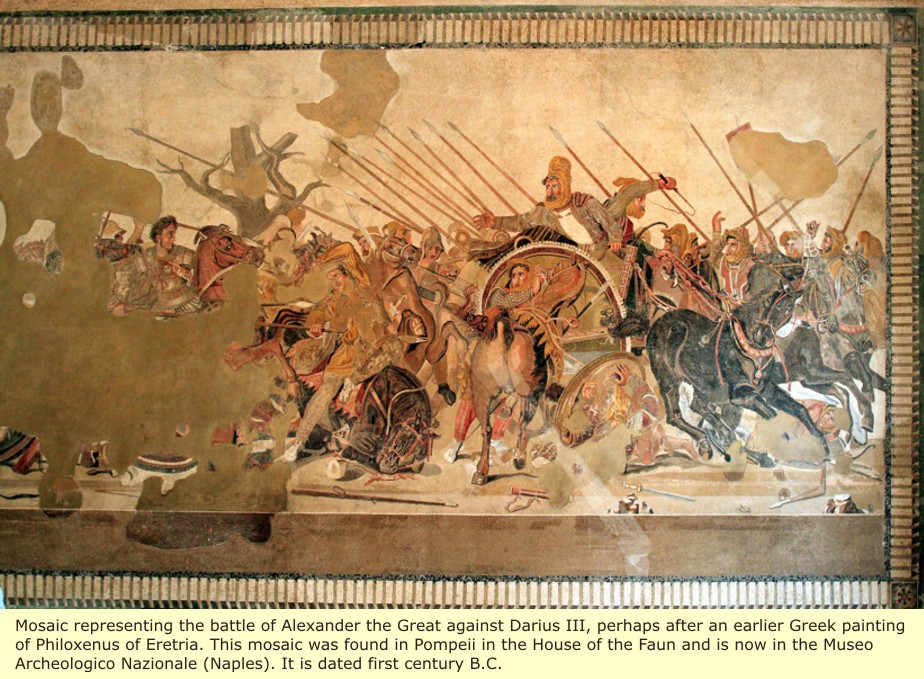 |
 |
| Click here to find out the true identities of the people depicted in the so-called "Alexander Mosaic" Click: >>> |
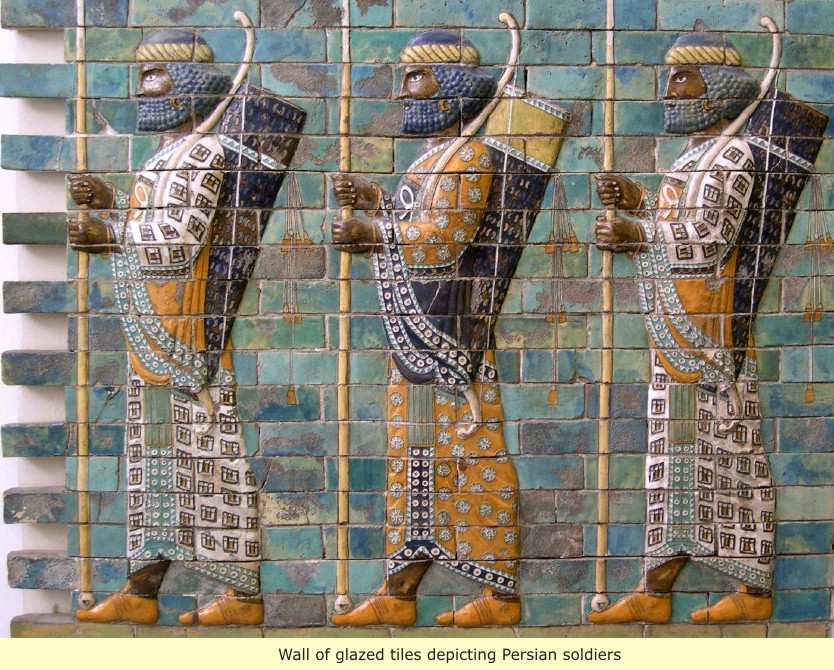 |
 |
 |
 |
 |
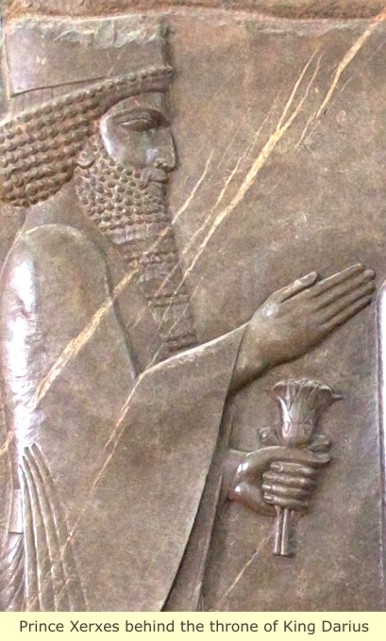 |
 |
(Persia ruled Egypt twice, for a total of 121 years)
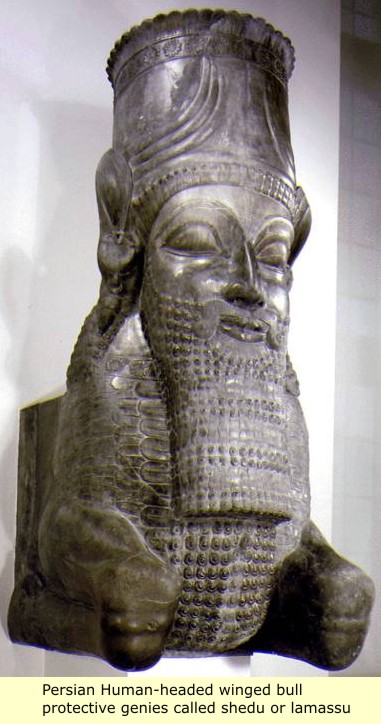
Here is how Herodotus describes some of the participants in the great battles, he tells us: The Eastern Ethiopians (Dravidians), for two nations of this name served in the army - were marshaled with the Indians. They differed in nothing from the other Ethiopians, save in their language, and the character of their hair. For the Eastern Ethiopians have straight hair, while they of Libya are more woolly-haired than any other people in the world.
Ethiopians - Greek word meaning: "burnt face" their term for all Blacks, usually denoting Blacks not of Egypt.
That is actually a lie created by Albinos for some racist, simple-minded reason that normal minds cannot comprehend. Unfortunately - to the Albino trying to hide his true nature and true past, a lot of stupid, cruel, and murderous, things make sense. This particular lie is deconstructed here: Click here: >>>
Libyans - Greek term usually denoting all of Africa except Egypt.
A curiosity: His differentiation of Indians, suggests that at this time, there is still a clear differentiation in India, between the native population and the Arian newcomers - apparently melding has not taken place yet. [The word India/Indian - derives from the Arian god "Indra"].
With Alexander's conquest of the Persian Empire, which included Mesopotamia, Egypt, and all other nations under Persian control. Greeks and other Europeans from all walks of life, were encouraged to migrate to the middle East and North Africa.
It was apparently Alexander's desire for Greeks and Persians to share one Empire. To promote harmony between his people and the Persians, he ordered eighty of his most important men, to marry highborn Persian women, in traditional Persian wedding ceremonies. He himself, married King Darius's daughter, who was named either Barsine or Stateira. His best friend Hephaestion, married Barsine's sister Drypetis. Alexander also began promoting Persians to high-ranking positions in his army, saying that Persians and Macedonians should share the empire. His efforts to create unity failed however; even the marriages between his men and the Persians mostly broke up after his death.
See: Additional Material Menu - for Persepolis, Apadana, and pictures of the people of the Persian Empire.
The Persian Kings were.. Achaemenes Cyrus II (The Great) |
 |
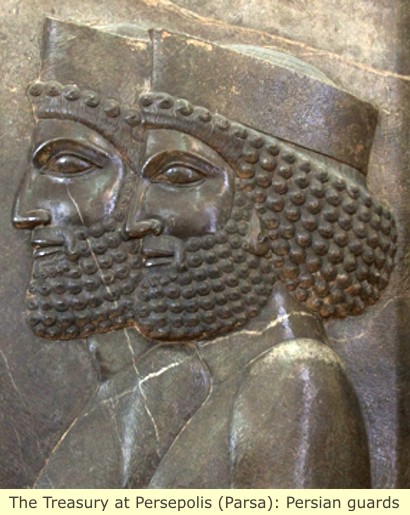 |
The Oxus treasure consists of about 170 objects, dating mainly from the fifth and fourth centuries B.C. The Treasure seems to have been gathered together over a long period, perhaps in a temple. It includes vessels, a gold scabbard, model chariots and figures, armlets, seals, finger-rings, miscellaneous personal objects, dedicatory plaques and coins It was found on the banks of the River Oxus, probably at the site of Takht-i Kuwad, a ferry station on the north bank of the river.
In May 1880 Captain F.C. Burton, a British political officer in Afghanistan, rescued a group of merchants who had been captured by bandits while travelling between Kabul and Peshawar. They were carrying with them this rich collection of gold and silver objects. Burton bought from them a gold armlet, now in the Victoria and Albert Museum. Other pieces from the Treasure subsequently emerged in the bazaars of Rawalpindi. Some of those now in The British Museum were acquired by Major-General Sir Alexander Cunningham (1814-93), Director General of the Archaeological Survey of India, and others were obtained by Sir Augustus Wollaston Franks, who was both a curator in the Museum and a generous benefactor. In due course Franks bought Cunningham's share of the treasure, and eventually the entire Oxus treasure was bequeathed by him to The British Museum
 |
 |
 |
 |
 |
 |
 |
Please visit the "Additional Material Area" for many more photographs of each civilization, and related material <Click> |
| < Back | Home | Next > |